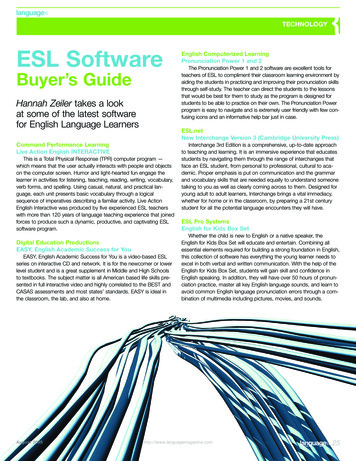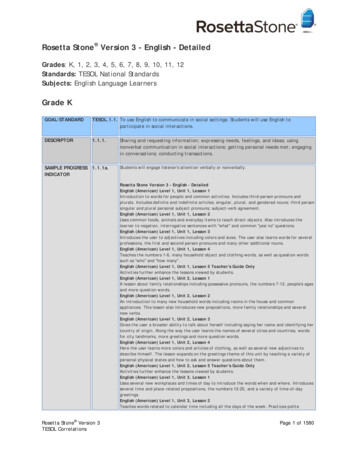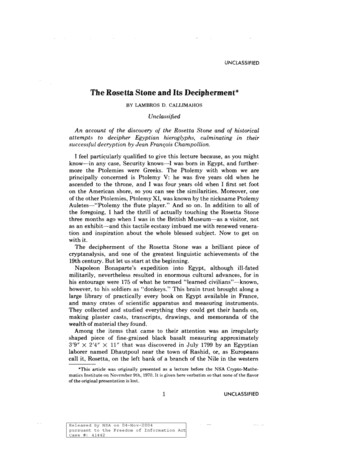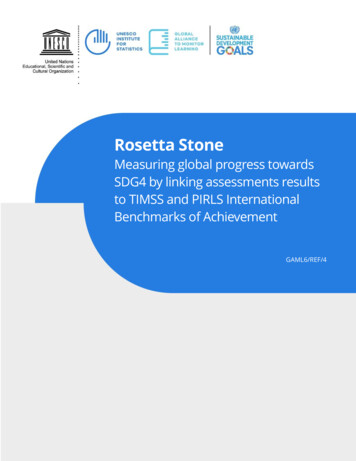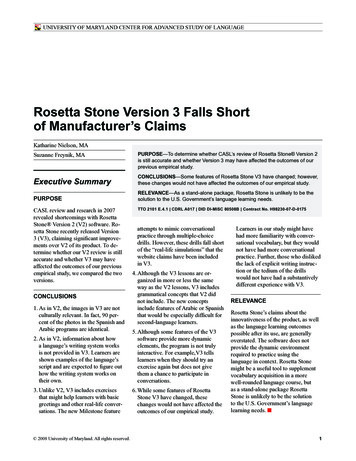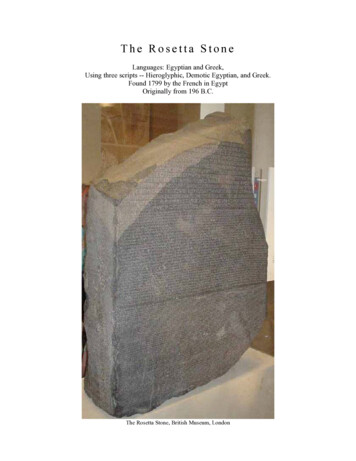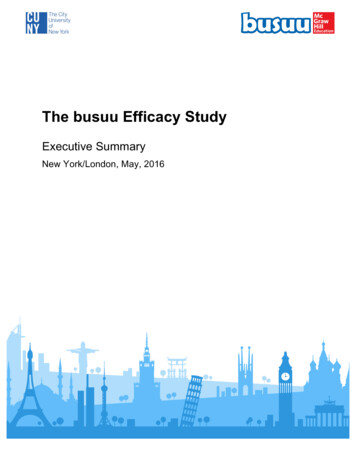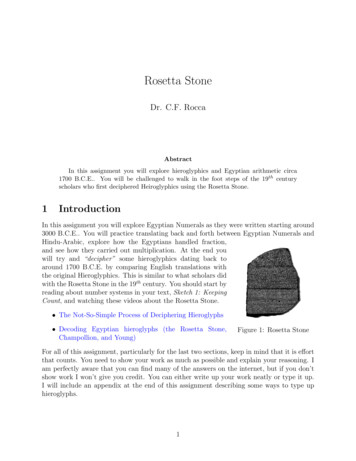
Transcription
Rosetta StoneDr. C.F. RoccaAbstractIn this assignment you will explore hieroglyphics and Egyptian arithmetic circa1700 B.C.E. You will be challenged to walk in the foot steps of the 19th centuryscholars who first deciphered Heiroglyphics using the Rosetta Stone.1IntroductionIn this assignment you will explore Egyptian Numerals as they were written starting around3000 B.C.E. You will practice translating back and forth between Egyptian Numerals andHindu-Arabic, explore how the Egyptians handled fraction,and see how they carried out multiplication. At the end youwill try and “decipher” some hieroglyphics dating back toaround 1700 B.C.E. by comparing English translations withthe original Hieroglyphics. This is similar to what scholars didwith the Rosetta Stone in the 19th century. You should start byreading about number systems in your text, Sketch 1: KeepingCount, and watching these videos about the Rosetta Stone. The Not-So-Simple Process of Deciphering Hieroglyphs Decoding Egyptian hieroglyphs (the Rosetta Stone,Champollion, and Young)Figure 1: Rosetta StoneFor all of this assignment, particularly for the last two sections, keep in mind that it is effortthat counts. You need to show your work as much as possible and explain your reasoning. Iam perfectly aware that you can find many of the answers on the internet, but if you don’tshow work I won’t give you credit. You can either write up your work neatly or type it up.I will include an appendix at the end of this assignment describing some ways to type uphieroglyphs.1
2Rosetta Stone2Egyptian Numerals2.1NumbersRecall that the Egyptians had different symbols for each power of 10 up to 1,000,000.1 10.0005102100,000610031,000,00071,0004Table 1: Quick Number ReferenceUsing this we can translate back and forth between Hindu-Arabic and Egyptian Numerals.1. 423. 31,04725. 2 4 42. 57 2 3 34. 3 76.2.2 3 3 3 3 3 3 3 3 3 4FractionsWhen writing fractions the ancient Egyptians worked almost exclusively in unit fractions(fractions with numerator 1), that is they would have written 2/5 as something like 1/3 1/15 . Using Egyptian numerals we would write, very roughly, as:rr 2Here the symbol r indicates that it is a fraction. An exception to this notation is for 1/2,which is written M instead ofr . One possible formula for finding the unit fractions is:211 ,nm n(m)where m (n 1)/2. For example we could write 2/7 as 1/4 1/28, since 4 (7 1)/2. Tryusing this formula for the following fractions:7.239.2711.2118.2510.2912.213This only works when n is an odd number. However, what is the simple way to write 2/4 asa unit fraction? Why would this always work when the denominator is an even number?One of the only exceptions to the unit fraction rule was 2/3 which sometimes had itsown special symbol
Dr. C.F. Rocca3r.From now on, for simplicity, we will write these fractions using lines or dots over HinduArabic numerals so the above examples would be 1/3 1/15 3 15 and 2/3 3̈.3Egyptian MultiplicationEgyptian multiplication was built around the idea that it is easy to double numbers. If wewant to calculate 15 6, we think of it as 15 2 15 4 because 6 2 4. Now all wehave to do is use doubles:15306012X4Xthus15 6 15 2 15 4 30 60 90.Here are a couple more, slightly more complication examples with whole numbers.23 17 ?23 1X46 292 4184 8368 16X23 368 39135 110 ?35 170 2X140 4X280 8X560 161120 32X2240 64X70 140 280 1120 2240 3850What we can see in these examples is that Egyptian arithmetic trades complicated multiplication tables for doubling (multiplying a number by 2 or adding a number to its self)combined with addition. This means you might need to do far more individual calculationsbut each one is a little simpler, this works well with their number system. Here is an example
4Rosetta Stonewith some fractions.13 1 25 ?1 3 15 1X2 3̈ 8 120 25 3 4 60 4X10 3̈ 2 30 8X 1 3 15 5 3 4 60 10 3̈ 2 30 17 2 3 4 15 30 60 18 10 12 60 18 5This is far more complicated than the calculations we would normally do, but you needto recall that they had a more simplistic additive notation for their numbers. Given theirnumber system this algorithm makes sense for them.Reflect on the Egyptian multiplication and see if you can do it.13. When we multiplied 23 by 17 why did we stop doubling when we got to 16?14. When we multiplied 13 1 25 where did the 1 3 15 come from?15. When we multiplied 13 1 25 how did we get that4 1 3 15 5 3 4 60?16. Redo the calculation of 35 110, but this time double the 110 and not the 35.17. Use the Egyptian multiplication by doubling to calculate 12 15. (Hint: we can write12 8 4, both powers of 2.)18. Use the Egyptian multiplication by doubling to calculate 25 18.19. Use the Egyptian multiplication by doubling to calculate 9 2 23 .On a final note, one advantage of Egyptian multiplication is that we can divide using theexact same method. If I want to calculate 22 7, I rewrite that as 22 (1/7) or 22 7.Then we can use the algorithm we already have.74 282 141 72 4 2812X4X816XSo we get a final answer of 3 7, which is what we would expect if we used out modernalgorithm for division to get 22 7. What this nicely highlights is that multiplication anddivision are very closely related operations.
Dr. C.F. Rocca45Moscow Papyrus Problem 6Now it is your turn to crack the Rosetta Stone. Figure 2 shows the calculations from problem6 on the Moscow Papyrus which is about finding the dimensions of an enclosed region. Youneed to carefully compare the English translation to the Egyptian and see if you can answerthese questions. 1Questions:20. In line 2 the author speaks of 2 arurae, this appears to be a measure of area. Readingthrough the rest of the text how many square units is this equal to?21. This piece of hieroglyphs uses spacial symbols for 4 and 2 can you spot them? Lookingat the way Egyptian multiplication works why might they have special symbols forthese fractions?22. How can we combine 2 4 with 1 to get 1 3? (Hint: what happens if you multiply2 4 by 1 3?)23. Using what you did in section 3, show how multiplying 1 3 by 2 arurae results in 16.(Hint: you need to answer problem 20 first.)24. Where in the diagram of hieroglyphics can we see the author multiplying 3 by 4?25. Which symbols seem to express the words “you are to”?26. Which symbols seem to represent the word “result”?English Translation of Problem 6:1. Example of calculating an enclosure.2. If you are told : An enclosure of a set and 2 arurae, the breadth having2 4 of the length: 3. You are to treat 2 4 so as to find 1; the result is 1 3.4. [You are to take] this [12] which is in a set and 2 arurae 1 3 [times]; result16.5. You are to calculate its square root; result 4-for the length, and the breadthhas 2 4 of it, namely 3.6. The correct procedure:41234 1X8 2X1This material on the Moscow Papyrus is from “Four Geometrical Problems from the Moscow Mathematical Papyrus” by Gunn and Peet in The Journal of Egyptian Archaeology, Vol. 15, No. 3/4 (Nov., 1929),pp. 167-185, available at https://www.jstor.org/stable/3854111
6Rosetta StoneFigure 2: Moscow Papyrus Problem 65Moscow Papyrus Problem 14Repeat what you did above in section 4 with this more complicated example. Figure 3shows the calculations from Problem 14 of the Moscow Papyrus for the volume of a truncatedpyramid. Compare the English translation with the figure and try to answer these questions.Questions:27. Where is the author calculating 4 2?28. Where is the author calculating 28 2?29. Where on the diagram does the author write that 3 of 6 is 2?30. What seems to be the symbol for squaring a number?31. What might be the symbol for a sum?32. Knowing what is supposed to be happening, can you glean where calculations are beingdone in the Egyptian sentences at the top of the hieroglyphics?English Translation of Problem 14:“If you are told: A truncated pyramid of 6 for the vertical height by 4 on thebase by 2 on the top: You are to square the 4; result 16. You are to double 4;result 8. You are to square this 2; result 4. You are to add the 16 and the 8 and
Dr. C.F. Rocca7the 4; result 28. You are to take 3 of 6; result 2. You are to take 28 twice; result56. See, it is of 56. You will find [it] right.”Figure 3: Moscow Papyrus Problem 14
8Rosetta StoneHieroglyphs AppendixIf you are doing work with hieroglyphics and need to insert them in a document here aresome ways to do that.As Graphics:One way to insert hieroglyphics is to copy and past images into your file. This is a littlesloppy looking and tedious but also simple. You can either Google the image you want,or use the a snipping/screen capture tool like Microsoft’s Snipping Tool App . Or youcan go to a website like this one Hieroglyphic Typewriter where you can use the virtualtypewriter to find the symbol you want and then right click on it to copy and paste it intoyou document.In Google Docs:You can insert Hieroglyphs in Google Docsby following the directions here How to addhieroglyphs to Google Docs and Slides. Thisis a little tedious but they will have whatyou need. One way to speed this up is tofind the character you need here EgyptianUnicode Block, then you can use the characters number code while inserting a specialcharacter by searching using that code andthen double clicking on the image.In Microsoft Word:Microsoft Word can insert symbols in the same way as Google Docs once you install thefonts. Here are directions for getting the fonts installed.Click on the link (https://dn-works.com/ufas/) and go down and click the font that’scalled Aegyptus, you will download a zip file on your computer which you can then extractby double clicking on it. After extracting the file, you will need to click and run these twofiles:Click Install for both files:
Dr. C.F. Rocca9This will install a new font on your computer that’s called Aegyptus. Once the font isinstalled, you can open up Microsoft Word and search for the font:To view the hieroglyphs, click the Symbol icon (probably in the insert ribbon):Click More Symbols:
10Rosetta StoneChoose Aegyptus as the font and Extended Characters as the subset, then click the hieroglyph you wish to insert:You can also now use the unicode numbers mentioned above. In Microsoft Word you caninsert unicode characters by typing the hex value of the character, e.g. U 13366 then typingAlt-x:3 3 33 3To help you find the numbers quickly here are the unicode numbers for some basic symbols:110100 23U 133FAU 13386U 133621,0004U 131BC10,0005U 130AD100,0006U 131901,000,0007U 13068Fraction SymbolrU 1308BTwo Thirds Symbolr U 1308CTable 2: Quick Number Reference with UnicodeIt is useful to notice that the 3 symbol is U 13362 and looking at the unicode chart if I333want six of those you can type the code U 13367 and press Alt x to get 3 3 3 .
2 Rosetta Stone 2 Egyptian Numerals 2.1 Numbers Recall that the Egyptians had di erent symbols for each power of 10 up to
